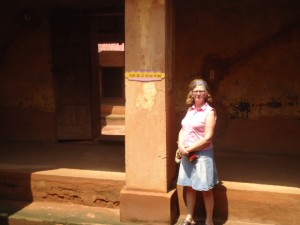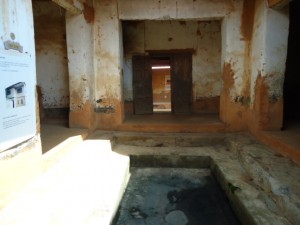Time in Cotonou was dedicated to adminstrative things, the mechanical work, banking, shopping. The city is a bit manic, with the most remarkable traffic, comprised principally of fast new motos and slow old trucks. It moves quickly, but it is crazy. We actually were laughing as we drove through, completely surrounded by motos at close quarters.
We left Cotonou on a Thursday via Porto Novo, the actual capital of Benin, inland a few kilometres to the north-east. We thought that perhaps Porto Novo was a created capital, like Brasilia in Brazil, or Abuja in Nigeria, but that is not the case at all. Porto Novo was first established by the Portugese as a slave trading centre in the 1600″s, and was made the capital of the colony by the French in the late 1800″s. a colonial centre (?) but is now another rambling African city with little to distinguish it. We did go the the Musee Homne, a reconstruction of the Palace of Tofa I, the first local king in a long dynasty that began in 1688 and ran until 1976, when a succession dispute led to the abandonment of the palace and its assumption by the state which then established the museum.
The museum is a small complex of simple one storey buildings linked together and tastefully restored. The lifestyle depicted has many similarities with what we know of that of Ghanaian chiefs. Today part of the governance system of Benin, like that of Ghana, consists of traditional leaders, known as chiefs in some countries, kings in other. In Benin the term King continues to be used, as we saw when we visited the village near Grand Popo (see earlier post). The feature of the complex in Porto Novo that really drove home for us the physical link between the past was the courtyard where the king held public events and ceremonies 400 years ago. It consisted of a large open square with covered areas just a few rows deep around the perimeter. A special, slightly higher place was for the king”. This kind of structure was clearly the inspiration for the durbar squares that exist throughout Ghana and where I have attended many functions. They are all even squares open in the middle with one side higher than the others for the dignitaries, just like the one at the Musee Homne. On the occasions I have attended no one sat in the large open middle of the square. It was empty except for intervals when traditional music and dance troupes appeared to provide entertainment. The Palace in Porto Novo was much more than this, and was very tastefully reconstructed to convey a sense of the myth and reality of the life of African kings, at least these ones.


